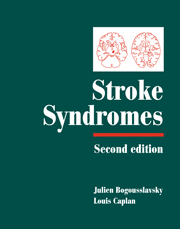Book contents
- Frontmatter
- Contents
- List of contributors
- Preface
- PART I CLINICAL MANIFESTATIONS
- 1 Stroke onset and courses
- 2 Clinical types of transient ischemic attacks
- 3 Hemiparesis and other types of motor weakness
- 4 Sensory abnormality
- 5 Cerebellar ataxia
- 6 Headache: stroke symptoms and signs
- 7 Eye movement abnormalities
- 8 Cerebral visual dysfunction
- 9 Visual symptoms (eye)
- 10 Vestibular syndromes and vertigo
- 11 Auditory disorders in stroke
- 12 Abnormal movements
- 13 Seizures and stroke
- 14 Disturbances of consciousness and sleep–wake functions
- 15 Aphasia and stroke
- 16 Agitation and delirium
- 17 Frontal lobe stroke syndromes
- 18 Memory loss
- 19 Neurobehavioural aspects of deep hemisphere stroke
- 20 Right hemisphere syndromes
- 21 Poststroke dementia
- 22 Disorders of mood behaviour
- 23 Agnosias, apraxias and callosal disconnection syndromes
- 24 Muscle, peripheral nerve and autonomic changes
- 25 Dysarthria
- 26 Dysphagia and aspiration syndromes
- 27 Respiratory dysfunction
- 28 Clinical aspects and correlates of stroke recovery
- PART II VASCULAR TOPOGRAPHIC SYNDROMES
- Index
- Plate section
10 - Vestibular syndromes and vertigo
from PART I - CLINICAL MANIFESTATIONS
Published online by Cambridge University Press: 17 May 2010
- Frontmatter
- Contents
- List of contributors
- Preface
- PART I CLINICAL MANIFESTATIONS
- 1 Stroke onset and courses
- 2 Clinical types of transient ischemic attacks
- 3 Hemiparesis and other types of motor weakness
- 4 Sensory abnormality
- 5 Cerebellar ataxia
- 6 Headache: stroke symptoms and signs
- 7 Eye movement abnormalities
- 8 Cerebral visual dysfunction
- 9 Visual symptoms (eye)
- 10 Vestibular syndromes and vertigo
- 11 Auditory disorders in stroke
- 12 Abnormal movements
- 13 Seizures and stroke
- 14 Disturbances of consciousness and sleep–wake functions
- 15 Aphasia and stroke
- 16 Agitation and delirium
- 17 Frontal lobe stroke syndromes
- 18 Memory loss
- 19 Neurobehavioural aspects of deep hemisphere stroke
- 20 Right hemisphere syndromes
- 21 Poststroke dementia
- 22 Disorders of mood behaviour
- 23 Agnosias, apraxias and callosal disconnection syndromes
- 24 Muscle, peripheral nerve and autonomic changes
- 25 Dysarthria
- 26 Dysphagia and aspiration syndromes
- 27 Respiratory dysfunction
- 28 Clinical aspects and correlates of stroke recovery
- PART II VASCULAR TOPOGRAPHIC SYNDROMES
- Index
- Plate section
Summary
Introduction
Vertigo is an unpleasant distortion of static gravitational orientation or an erroneous perception of motion of either the sufferer or the environment. It is not a well-defined disease entity, but rather the outcome of many pathological processes causing a mismatch between the visual, vestibular, and somatosensory systems, all of which subserve both static and dynamic spatial orientation. Physiological and clinical vestibular vertigo syndromes are commonly characterized by a combination of phenomena involving perceptual, ocular motor, postural and vegetative manifestations: vertigo, nystagmus, ataxia and nausea (Brandt & Daroff, 1980). The vertigo itself results from a disturbance of cortical spatial orientation, while nystagmus and ocular deviations are secondary to a direction-specific imbalance in the vestibulo-ocular reflex. Postural imbalance and vestibular ataxia are caused by inappropriate or abnormal inactivation of vestibulospinal pathways. Unpleasant vegetative effects, such as nausea and vomiting, are related to clinical activation of the medullary vomiting centre (Brandt, 1991b).
Most of the central vestibular syndromes and some of the peripheral vestibular syndromes may have a vascular etiology (Baloh, 1992; Brandt & Dieterich, 1994a). Ischemia can be responsible for a wide range of vestibular syndromes; most of the central and some of the peripheral vestibular syndromes are listed in Table 10.1. Ischemia will sometimes produce a combination of central and peripheral symptoms, as in anterior inferior cerebellar artery (AICA) infarctions, the territory of which encompasses the labyrinth, pontine, and cerebellar structures (Atkinson, 1949). In migraine and in vertebrobasilar ischemia, it may not be possible to determine whether the vertigo is a symptom of a peripheral or a central vestibular syndrome. The course and prognosis of the vertigo syndrome are variable.
- Type
- Chapter
- Information
- Stroke Syndromes , pp. 129 - 143Publisher: Cambridge University PressPrint publication year: 2001
- 8
- Cited by



